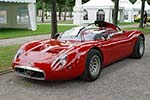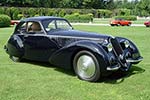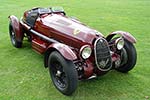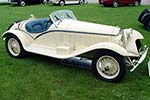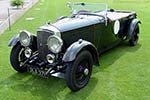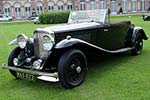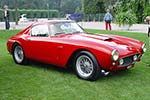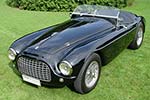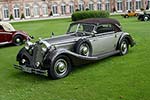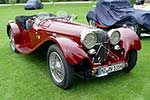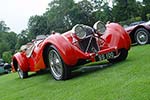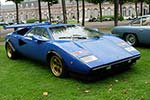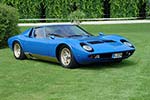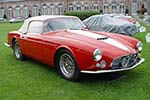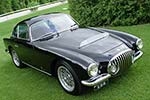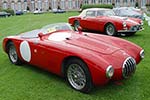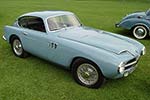
For the third consecutive year, the gardens of the Schwetzingen castle hosted one of Europe's finest Concours d'Elegance. These beautiful gardens are worth a visit alone, but filled with 150 of the finest cars they can't be missed. Featured marques in this year's event were Alfa Romeo, Bentley and Jaguar, and all were honoured with a separate class. A fourth theme class was dedicated to Italian designer Pietro Frua, who was born 90 years ago. Eight more classes, organised by type and era, completed the concours. Read on for a review of the event and the finest cars entered, and check out the
slideshow made up of 100 high resolution images.
Most of the pre-war cars were present in the first three classes, which were divided by age; pre 1918, 1919 - 1930 and 1930 - 1939. All the great makes of the pre-World War II era were represented on the German grass.
The oldest car entered and probably one of the first constructed was a Benz Victoria Vis-a-Vis of 1893. Vis-a-Vis is French for face to face and describes the seating position found on many of the early cars, which was derived directly from the carriages most of these were based on. In the following years automotive design quickly progressed, offering drivers both more protection from the elements and more power to travel around at higher speeds than ever thought possible. An examples of this evolution is the lovely Hispano Suiza Alfonso Tourer of 1912.
In the 1920s Rolls Royce had quickly earned a reputation for building the most durable and luxurious cars available. Although they were far from revolutionary, Rolls Royces served as an example for many other manufacturers. The Rolls Royce 40/50 Silver Ghost Brewster Pallmall Torpedo Tourer entered does this solid reputation justice. When the demand for airplanes decreased dramatically at the end of WWI, Gabriel Voisin, like many other aircraft designers, was left without a job. He quickly turned to the non-military automotive industry and in the years to come he developed a very characteristic style, combining his aviation background with influences from Bauhaus architecture. The flowing lines of the fenders in combination with the very square passenger compartiment really give the Voisin C11 a unique profile.
Coach-builders were mostly responsible for the designing and building of the bodywork in 1930s, with manufacturers focussing on building rolling chassis. One of the few high-profile manufacturers that stuck to in-house design was Bugatti and a look at the Jean Bugatti designed Type 57 Atalante explains why. The styling duo of Figoni & Falashi were two of the absolute masters whose designs for mostly French chassis are among the most famous of the pre-WWII era. A Concours d'Elegance regular, the Delahaye 135M Figoni & Falashi Roadster is a great example of their voluptuous style.
Sharing a piece of the pie-shaped garden were the post-war Grand Tourismo and the Sports Racer classes. Similar in many aspects the former were designed and built with luxury in mind, whereas the latter were built to perform on racing tracks all over the world.
A mainstay in Ferrari's competition and customer line-up for nearly a decade was the 250 GT model. Multiple versions were presented; a 250 GT SWB Competizione in the Sports Racer class and a 250 GT Series I Cabriolet and 250 GT Lusso in the Grand Tourismo class. Designed solely as a Grand Tourer was the Lamborghini Miura of which a breathtakingly perfect example was present. One of the most interesting cars on display was the OSCA MT4 Vignale Coupe, which was a 1955 one-off built for the Turin Motor Show. Today, almost 50 years later, it is in an incredible unrestored condition; the wheels are still shod with the original Michelin tires.
Although many of the 150 cars entered featured custom body-work, there were two classes dedicated especially to cars fitted with unique coachwork. The 'special coachwork' classes were separated in a pre-WWII and a post-WWII class. Rivalled by none in class and style was the Horch 710 Special Roadster of 1934. Its striking two-seater body was designed and built by Reinbolt & Christe in Basel, Switzerland. Striking is also the first word that comes to mind when looking at the Delahaye 135MS Poutrout Aerodynamic. Both its elegant body and the creme with red paintjob made this Delahaye hard to miss. Perhaps not as striking as the aforementioned vehicles, the Pegaso Z102 Touring Berlinetta is just as interesting. Powered by a quad-cam V8 engine, the Spanish built Z102 was one of the most sophisticated cars of its day. American motoring was represented by the Imperial Crown Wedge of 1961. The fully equipped pink interior features
an 11 record radio.
Entered in the 'un-restored' class was one of the rarest cars of the show, the Monteverdi 375S Fissore Highspeed Berlinetta. Built in Switzerland in the late 1960s and 1970s, Monteverdis are not seen often. This particular model is just one of 11 cars constructed.
The four theme classes gave the visitors the opportunity to follow the evolution of the featured marques and designer over the years.
The oldest Alfa Romeo present was the RLSS Targa Florio racer. In contrast the 1600 Zagato Coupe was the most modern Alfa Romeo entered, with 50 years between the two. Alfa Romeo's glory-years were without a doubt, the 1930s, with the great Vittorio Jano as the chief engineer/designer. His straight-eight engine served throughout the '30s in Grand Prix racers, endurance racers and road going supercars. Three of these 8-cylinder Alfas were entered with the clear highlight being the 8C 2900B Touring Berlinetta, which was awarded the 'Best of Show' title. The 6C 2500 SS range was the final exploit of Jano's design and for a period of time it was the most expensive car on the market. Soon after WWII, Alfa Romeo dropped their supercar production in favour of mass-producing of affordable four-cylinder cars. The Milanese firm didn't completely lose their touch and slowly started constructing faster versions of the 1900 model. Fitted with a Zagato body, the Alfa Romeo 1900 SS was one of the quickest GT-racers in its class. The mid-engined Alfa Romeo Tipo 33 completed the return to the supercar league in 1967.
2003 is one of the most important years in Bentley's history; after 70 years, the company is independent from Rolls Royce again. The new chapter in the Bentley book could not have started better than it did, with Bentley scoring a one-two in the LeMans 24 Hours race.
A pre-production version of the upcoming Bentley Continental GT model drew the interest of many visitors. The Bentley class in the Concours was divided in three sub-classes for each of the three locations where Bentleys were constructed over the years: Cricklewood, Derby and Crewe. Cricklewood is where some of the most famous Bentleys were constructed. These include W.O. Bentley's own favourite, the Speed Six and the 4.5 litre, supercharger-powered Blower Bentley. After WWII the works moved to Crewe, where they are still located to this day. Most famous of all post-war Bentleys is the elegant R-Type Continental Coupe of which a Mulliner bodied example was present.
Ninety years after his birth and twenty years after his death, Pietro Frua was placed in the spotlight. Best known are his production models for Maserati and Glas/BMW. The Maserati Mistral is one of his finest designs of the 1960s. Together with the production cars, various one-offs designed by Frua were present. Some of Frua's finest specials were based on the Maserati A6 chassis, with one of the 17 spiders designed by him entered. Interestingly none of these 17 cars were exactly the same.
Coventry is for Jaguar, what Maranello is for Ferrari. In 2003, Jaguar celebrates its 75th anniversary of their move to Coventry in 1928. At the European Concours d'Elegance, Jaguar was represented both in a separate class and a feature display of the Jaguar Daimler Heritage Trust. Entered in the Concours was the 1953 LeMans 24 Hours winning Jaguar C-Type s/n 051.The Russian-born designer Jacques Saoutchik added elegance to one of Jaguar's models with a special SS 100 on display. The Heritage Trust display included some of the most important Jaguars ever built. One of the first sportive successes scored with the XK-engine was winning the Alpine Rallye in 1950 with the Jaguar XK120 'NUB120'. Other notable cars included the XK SS, XJ 13 and the XK 180 prototype.
The combination of the breathtaking gardens and the stunning automobiles gathered made the 2003 edition of the European Concours d'Elegance a wonderful success! To give you a great impression of the event we compiled a
100 shot slideshow.

 For the third consecutive year, the gardens of the Schwetzingen castle hosted one of Europe's finest Concours d'Elegance. These beautiful gardens are worth a visit alone, but filled with 150 of the finest cars they can't be missed. Featured marques in this year's event were Alfa Romeo, Bentley and Jaguar, and all were honoured with a separate class. A fourth theme class was dedicated to Italian designer Pietro Frua, who was born 90 years ago. Eight more classes, organised by type and era, completed the concours. Read on for a review of the event and the finest cars entered, and check out the slideshow made up of 100 high resolution images.
For the third consecutive year, the gardens of the Schwetzingen castle hosted one of Europe's finest Concours d'Elegance. These beautiful gardens are worth a visit alone, but filled with 150 of the finest cars they can't be missed. Featured marques in this year's event were Alfa Romeo, Bentley and Jaguar, and all were honoured with a separate class. A fourth theme class was dedicated to Italian designer Pietro Frua, who was born 90 years ago. Eight more classes, organised by type and era, completed the concours. Read on for a review of the event and the finest cars entered, and check out the slideshow made up of 100 high resolution images.

